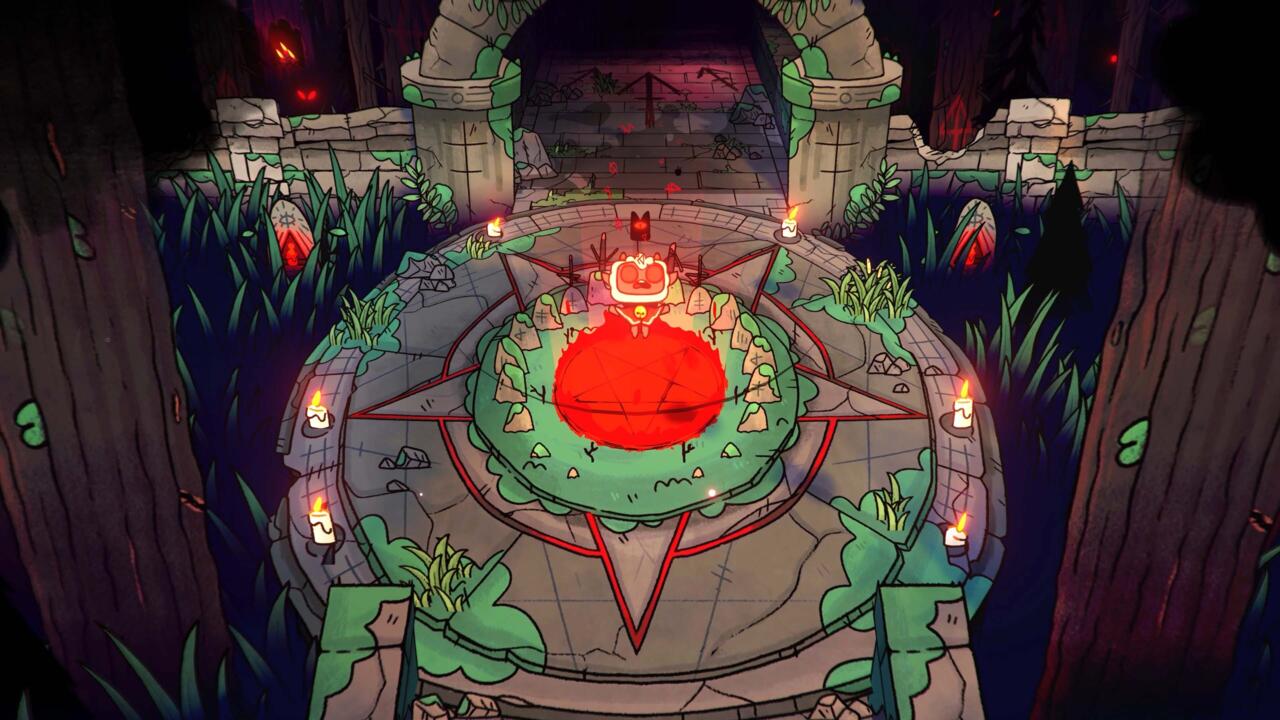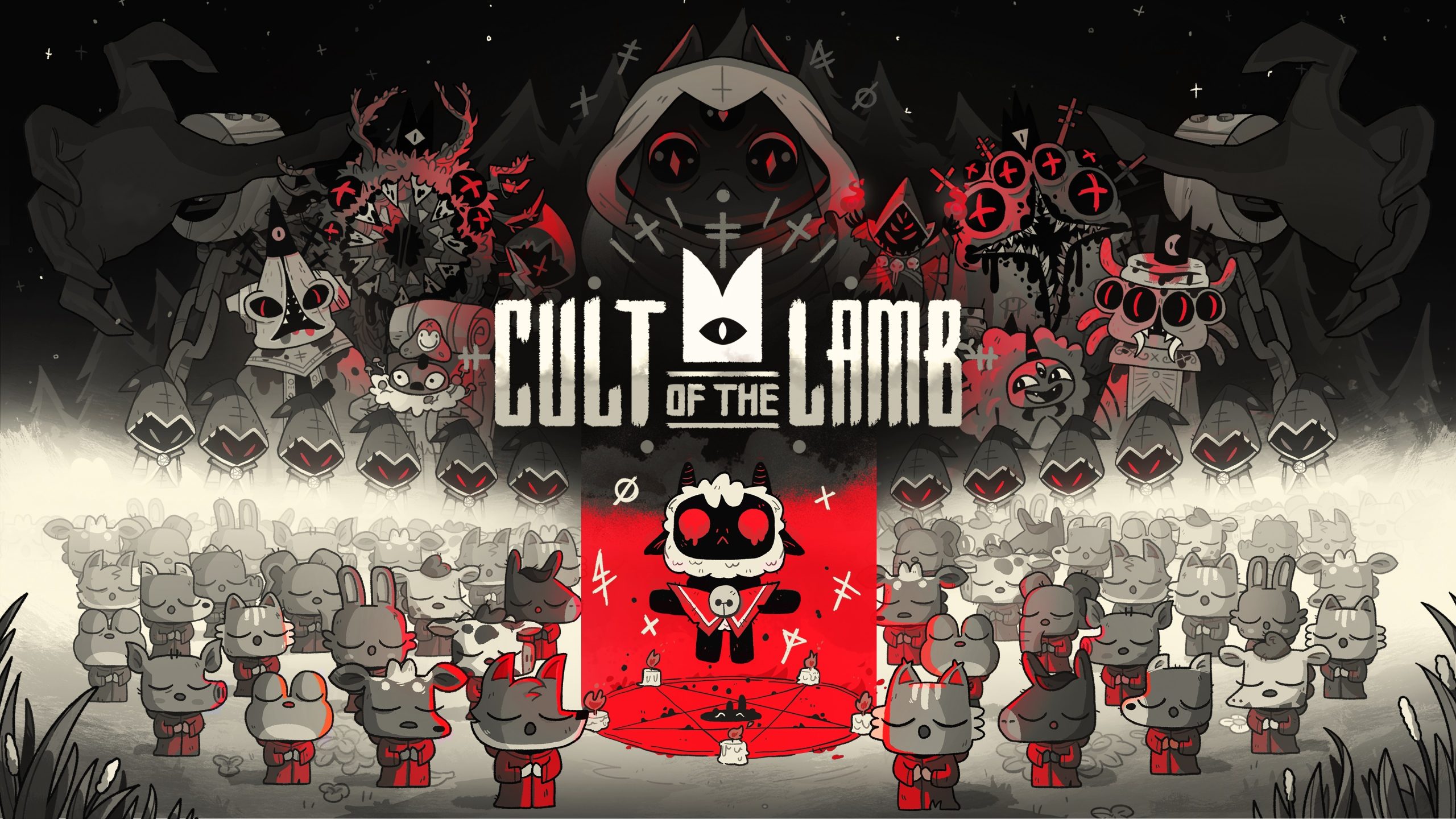Nine times out of 10, being a lamb led to the slaughter is not the best position to find yourself in. That tenth time, however, is while playing Massive Monster’s Cult of the Lamb, a delightfully demented roguelike that combines fast-paced dungeoneering, bold art, dark topics, and real-time simulation elements to create a one-of-a-kind experience. It couples two popular genres and smartly avoids their potential pitfalls while showcasing the best things they bring to the table. Take all this and add a simple but engaging narrative, and you’ve got a cult classic game well-worth playing.
Cult of the Lamb begins at our poor, titular lamb’s end. After walking down a narrow stone corridor, you are greeted by robed cultists and The Old Gods: four monstrous beings to whom the inhabitants of this strange land are (mostly) loyal. As it turns out, this little lamb is the last of its kind, having managed to evade death while the rest of its fluffy friends were culled. The Old Gods reveal this was due to a prophecy that a lamb would be the one who would lead to their undoing, destroying the Old Faith and unleashing the one thing they fear most: The One Who Waits. The Gods instruct their followers to dispatch you quickly, but little do they know this is precisely what the prophecy demands.
Upon being killed, you meet with The One Who Waits, an all-powerful god who we learn was betrayed and imprisoned by the other four. After your meeting, he makes you an offer: start a cult in his name, and he will both bring you back to life and gift unto you his former powers via the Red Crown. After you accept, you are sent back to the world of the living, where you meet with The One Who Waits’ former cult leader, Ratau, who leads you to the site of your up-and-coming commune. From this point, the game divides into two main sections: exploring dungeons and managing your cult, both of which are closely tied to one another.
There are four main dungeons in Cult of the Lamb, and each of these domains is led by one of the Old Gods. Each also contains features, resources, blueprints, follower forms, and enemies unique to that area. The dungeons are composed of a series of randomly-generated location types arranged on a webbed map, allowing you to evaluate their icons and choose the path you wish to follow. The most common types are combat areas, which are denoted on your map by a sword icon. Each of these areas is made up of a handful of randomly-generated rooms, occupied by monsters or, if you’re lucky, a mysterious figure weidling tarot cards that grant you various boons. Other types of areas include ones filled with resources for your commune, shops, a character issuing you special challenges–such as “don’t take damage in the next three rooms”–story beats, malevolent pentagram chambers, and new followers.
Your main objective while exploring these dungeons is to reach the end four times–slaying a different mini-boss each time you accomplish the feat–and then ultimately facing off against one of the four Old Gods. Upon finishing them off, all enemy units grow stronger, a new boss enters the final area, and you gain the ability to venture out repeatedly instead of having to return to your cult after each expedition–adding some major replayability and giving you the chance to grind a bit when later areas prove challenging.
While Cult of the Lamb has a fair amount of options that make it more approachable, it is inherently a fast-paced and challenging game. Though enemies tend to have predictable move sets you can pick up on fairly quickly, rooms can quickly become over-crowded thanks to additional monsters spawning and all the various long-range attacks more elite units will throw your way. Dodging is vital to staying alive, and if you’re playing on PC, I highly recommend assigning it to a button on your mouse–unless you want your space bar to also be a sacrificial lamb as well.
Not only that, but like most roguelikes, a great deal of the game is dictated by chance. You have no choice in what weapon and curse–a special attack fueled by fervor you collect from killing enemies–you begin each expedition with. While swords and axes might offer pretty standard speeds and attack rates, daggers are considerably weaker but attacks are quicker and battle-hammers are so slow you have to click twice to use them–though they do pack a big punch. This randomization is a big factor in what can be some broad difficulty swings, but it also creates a lot of rewarding moments when you overcome the drawbacks you can face.
I finished my first playthrough of Cult of the Lamb on normal and was faced with a bit of resistance toward the end of the second area, which ultimately pushed me to be more thoughtful and patient going forward. However, there are a few instances where you might bump into difficulty spikes and have a hard time accumulating resources, leading to skill stagnation and, as a result, difficulties on expeditions. Course-correcting isn’t too painful–I began to revisit dungeons and go to resource-filled rooms rather than ones filled with enemies or followers–but these moments can be frustrating.
In addition to normal mode, I tried the game on both easy and hard modes to get a feel for what the differences were. I was happy to find that, mechanically, everything stays essentially the same regardless of what difficulty you are at (though admittedly I didn’t test out the fourth and most challenging difficulty). What is impacted by difficulty is the size of enemy health bars and the resources you are given, which makes it rewarding to play on a lower difficulty in order to learn the ropes and improve before ramping it up. If you do find the game getting easier for you–or are feeling overly challenged and need a breather–you can change the difficulty back and forth at will.
Cult of the Lamb couples two popular genres and smartly avoids their potential pitfalls while showcasing the best things they bring to the table. Take all this and add a simple but engaging narrative, and you’ve got a cult classic game well-worth playing
Also included in the options you can quickly adjust are a few helpful accessibility settings. In the game’s menu, you can reduce camera motion, screenshake sensitivity, and the dithering fade distance–all of which can help those who might have motion sickness or particular visual impairments. You can also scale the text larger and turn off animated text, making the game more legible. Last but certainly not least, you can toggle flashing lights off, which is a great feature for those who might have epilepsy or any sort of light sensitivity.
While a substantial portion of the game takes place inside of dungeons, equally as important are the grassy plains you call home. It is here you are tasked with creating a little slice of paradise for the woodland creatures who call you their leader. This includes ensuring they have places to sleep, food to eat, and, uh, a sanitary environment. While you might be on the top of the social hierarchy, let’s just say it doesn’t quite feel that way when you are serving your cultists meals and scooping up piles of bodily fluids. Regardless, once their basic needs are met, your followers will happily work for you, gathering wood and stone as well as generating devotion, which in turn helps you upgrade and decorate your compound.
Also incredibly important to your cult’s success is their overall faith in you. Your faith meter is impacted by how victorious you are on your expeditions as well as how you treat your followers. Interrupting your followers while they are having discussion with one another can cost you a few faith points, whereas conducting a ritual in your temple involving animal sacrifice might cause mass panic and disdain. This forces you to find a balance between keeping your cultists happy and indulging in selfish acts that increase your strength. If your faith drops too low, your less loyal followers might start to dissent, sowing seeds of doubt and chaos throughout the cult. You can stave off a potential coup by attempting to re-educate dissenting followers, but this is a slow process. You also have the option to imprison them or even take ’em out back and finish them off, though the latter might lead to even more discontent.
Now, you might be wondering what just about every character in this game is wondering at any given time right now, “okay, sure I want my cult to thrive, but what’s in it for me?” The most important building in your commune is your temple, which is where you can acquire all the upgrades that will help you on your expeditions. If your cult isn’t happy, you won’t be too happy either as the game progresses. At your temple, you can conduct daily sermons that fill up a meter, ultimately unlocking permanent dungeon upgrades. These include things like increased attack, starting off with higher-level weapons and curses, and receiving new types of weapons, such as ones laced with poison or that resurrect the enemies you kill as vengeful spirits keen on helping you.
In addition to giving sermons, you can use the temple atlar to declare doctrines, change a few key pieces of your build, and conduct rituals. Declaring doctrines is where you see the greatest amount of player choice in the game, as you can decide whether you’d prefer to be loved or feared by your followers. There are five categories of doctrines you can choose from, each with four guiding questions that shape how your cult functions. For example, one of these categories is life and death, and poses queries about how you wish for your followers to view dying. You can choose to place importance on burials, or take a more economical stance and turn bodies into fertilizer.
Interestingly enough, the game actually gives you a lot of room to exert some level of benevolence. Sure, you might be a violent, pseudo-dictator at the head of a budding theocracy, but you have a fair bit of control over how you treat the people who follow you. If you have no desire to sacrifice your cultists to the tentacled being that lies below or to use them for personal gain, you don’t have to. You can assure your followers there is life after death, help them ascend to heaven, ensure they eat and sleep well, and even give them days of rest. Best of all, it never feels as if you are punished or placed at a disadvantage for playing this way. As a person who struggles with selecting the “renegade” option in any game, it was refreshing to see that either playstyle was completely viable and being grotesquely power-hungry didn’t necessarily equate to being grotesquely powerful.
Beyond the stretches of your compound are a few other special locations, with both a dice and fishing mini-game tucked away in them. Despite how many pieces and systems there are in Cult of the Lamb, they come together in complete cohesion. Not once did I feel overwhelmed by all its moving parts, nor did I ever feel like what I was doing was repetitive. Every mechanic, skill tree, and system comes together to harmonize with the resource collection, management, and combat aspects of the game.

Also working in harmony is the game’s art direction and dark-yet-playful tone. The woodland creatures that make up Cult of the Lamb’s cast of characters resemble Saturday morning cartoon characters, albeit with ritualistic markings adorning their cute and cuddly forms. The game uses color masterfully, with certain palettes designated to certain areas yet remaining rich and vibrant throughout the game. Your commune and neighboring areas, for instance, tend to use more naturally occurring colors, while locations associated with the occult favor deep reds and mystic purples. Adding to the supernatural element of the game is how its animations almost breathe, pulsing, strobing, and dithering with your gameplay, adding an almost haptic sensation. The upbeat-yet-unnerving music is sickly sweet and creates a distinct contrast between the cute visuals and the undercurrent of impending doom–the appropriate vibe for a cult. These jaunty tracks are successful in blending into the background–which is incredibly important in titles with inherently repetitive gameplay–while also being memorable and suiting the overall tone perfectly.
Lastly, while a plethora of recent games might have more poignant things to say about death, Cult of the Lamb offers a fun and more light-hearted take on the subject, leaning more into chaotic nihilism. The bulk of its focus is instead on the acquisition and transfer of power–as well as how easy it is to lose it. Naturally, these themes take the game into some dark places, but it manages to do so without ever feeling like it’s trying too hard to be edgy.
All of these elements come together to solidify Cult of the Lamb as a standout title in both the roguelike and simulation genres, as well as a one-of-a-kind entry that exists in the middle of them. Whether you are exploring the dungeons or expanding your cult, the experience is enjoyable, challenging, and more than a bit demented. With how surprisingly dense each of these parts are, the fact that all the pieces come together as smoothly as they do is a triumph.






